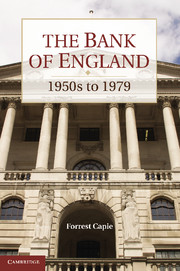Book contents
- Frontmatter
- Contents
- List of Illustrations
- List of Figures
- List of Tables
- Foreword by Mervyn King
- Preface
- Acknowledgements
- Abbreviations and Acronyms
- 1 Introduction and Overview
- 2 The Bank in the 1950s
- 3 The Monetary Setting and the Bank
- 4 The Bank's External Responsibilities to 1964
- 5 From Crisis to ‘Crucifixion’
- 6 Domestic Monetary Policy after Radcliffe
- 7 Other Activities and Performance
- 8 Sterling from Devaluation to Smithsonian
- 9 The Road to Competition and Credit Control
- 10 Competition and Credit Control
- 11 The Secondary Banking Crisis
- 12 Banking Supervision
- 13 Monetary Targets and Monetary Control
- 14 The Bank and Sterling in the 1970s
- 15 The Bank's Freedom to Operate
- 16 Epilogue
- Bibliography
- Index
- Titles in the series
4 - The Bank's External Responsibilities to 1964
Published online by Cambridge University Press: 05 July 2011
- Frontmatter
- Contents
- List of Illustrations
- List of Figures
- List of Tables
- Foreword by Mervyn King
- Preface
- Acknowledgements
- Abbreviations and Acronyms
- 1 Introduction and Overview
- 2 The Bank in the 1950s
- 3 The Monetary Setting and the Bank
- 4 The Bank's External Responsibilities to 1964
- 5 From Crisis to ‘Crucifixion’
- 6 Domestic Monetary Policy after Radcliffe
- 7 Other Activities and Performance
- 8 Sterling from Devaluation to Smithsonian
- 9 The Road to Competition and Credit Control
- 10 Competition and Credit Control
- 11 The Secondary Banking Crisis
- 12 Banking Supervision
- 13 Monetary Targets and Monetary Control
- 14 The Bank and Sterling in the 1970s
- 15 The Bank's Freedom to Operate
- 16 Epilogue
- Bibliography
- Index
- Titles in the series
Summary
In the nineteenth century, the Bank's principal function had been to maintain gold convertibility. In the 1920s, there was an attempt to restore the gold standard that had been disrupted by war and that was achieved somewhat unsatisfactorily as the gold exchange standard. And although central banks were in the main still private institutions, the discipline of maintaining gold convertibility was felt to be a sufficient check on their activity. After 1945, the desire was to return to something close to the nineteenth-century gold standard but with improvements. The Bretton Woods arrangements, however, were faulty and stumbled along uncertainly from their introduction in 1947 through their fuller realisation in 1958 to their demise at the end of the 1960s. The period sees sterling and the ‘system’ under constant pressure – sterling because it was one of the two reserve currencies, and if it went, pressure would shift to the dollar. Thus the background to the problems that were to dominate in international finance in the 1960s lies in the nature of the Bretton Woods arrangements. At the heart of the problem lay the scale and distribution of gold reserves and how they might change. At the end of the Second World War, the United States had gold reserves of $20 billion, about 60 per cent of total official gold reserves. That seemed more than enough to defend the dollar parity. In fact, US reserves grew and peaked at $25 billion in 1949.
- Type
- Chapter
- Information
- The Bank of England1950s to 1979, pp. 138 - 192Publisher: Cambridge University PressPrint publication year: 2010



